Finding Perast felt almost accidental. Only, it wasn’t really an accident because we were looking for the place, and because there’s only literally one road into and out of the village—one side bordered by mountains that loom ominous on a gray day, the other fringed by the placid, beautiful Bay of Kotor.
My wife, Yuliya, and I had been watching the bay unfold on the right side of the bus on the ride from the Montenegrin city of Kotor, when suddenly the bus pulled to a stop at an otherwise lonely shed alongside the road, seemingly in the middle of nowhere. The driver looked at Yuliya and nodded, acknowledgment that this was where we should exit.
As the bus motored away, a vast, echoing silence descended. No cars. No people. Just us.
We looked around and saw a narrow, one-lane street to our left—the only option. So, we started walking. Five minutes on, we came into a quintessentially quaint, seaside village that, aside from a few workmen and one or two open cafés, was all but devoid of life: Perast.
Let me stop here and say that at pretty much any other time of year, the village of Perast, Montenegro, is a happening place. It’s the playground of the rich, packed with million-dollar, stone, Italianate villas that, set against this particular backdrop, look stolen from somewhere in Italy’s mountainous Lake Como district. The scenery feels epic in its grandeur. As such, Perast draws swarms of tourists in spring and fall, and particularly summer, who fill the bayside al fresco cafés, downing Negronis and Aperol spritzes, noshing on fresh oysters and mussels pulled from the numerous farms that dot the bay, and soaking up the warm, Adriatic sun.
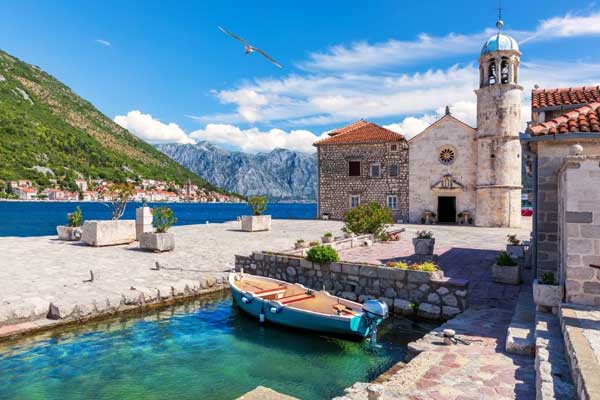
But Yuliya and I had arrived in the dead of winter, a couple of days after getting married on a seaside cliff in Budva, about an hour to the south. We had a few days to explore while local authorities translated our marriage certificate into English (for me) and Russian (for Yuliya). And, so, we went exploring the coast of Montenegro.
Until 15 years ago, Montenegro spent the entirety of its history subsumed within the borders of other empires and other countries. Today, it’s one of six countries that emerged from the breakup of Yugoslavia that began in the early 90s. Russians, Hungarians, Ukrainians, Czechs—pretty much the whole of the former Iron Curtain countries—have long known about Montenegro’s charms and its Homeric beauty. But only in the last few years has the country begun to pop up as a holiday destination for Western tourists.
Which means that now is a good time to put Montenegro on your list of must-see countries, before it’s overrun. The place is still quiet and under-touristed relative to so many other European destinations, but that won’t remain the case for long. The coast of Croatia once fit that bill, too, and today Dubrovnik, just 50 miles to the north, is one of the more over-touristed spots on the continent. Montenegro is not there yet, largely because it remains relatively unknown to so many Western travelers. But the walking that Yuliya and I did in Budva, Kotor, and Perast hints at the future. Numerous new hotels and apartment towers are rising up; many come with applications for Montenegrin residence and a passport, which is appealing to wealthy non-Europeans and Russians who want European citizenship.
I expect to see coastal Montenegro boom in the next couple of years. So, let’s get to know this part of the Balkan Peninsula before the inevitable invasion…
Start with Budva
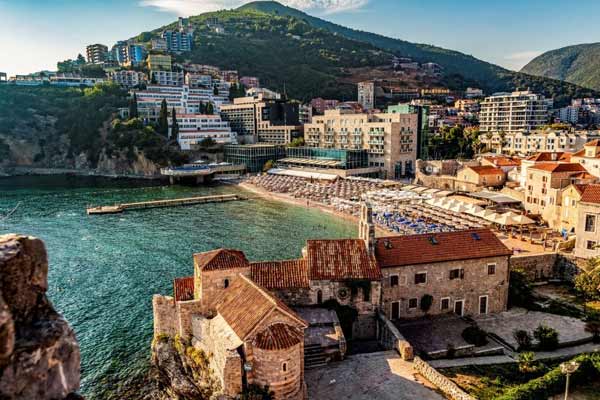
There are just two international airports in Montenegro: Podgorica, the national capital, and Tivat, near the primary coastal city of Kotor. Chances are high you will arrive in Podgorica since the only fights into Tivat are from neighboring Serbia.
Frankly, Podgorica is not the most attractive city in eastern Europe. I’d use it simply as a gateway to explore other parts of the country You can hire a taxi to take you from the Podgorica airport to Budva, an hour away, for roughly €50 ($60; Montenegro uses the euro as its currency).
Budva is where you want to start your exploration of Montenegro’s Adriatic coast. This city—town, really—is home to fewer than 20,000 people. But it’s the center of what’s known locally as the Budva Riviera, a relatively short, eight-mile stretch of sometimes sandy, sometimes pebbly beaches surrounded by mountains that plunge into the sea. Some of those beaches are right in the heart of Budva while others are more secluded but easily reached by bus, taxi, or rental car.
Budva’s been here for more than 2,500 years, making it one of the oldest towns on the Adriatic. It has a beautifully preserved Old Town of ancient, gray-stone buildings with red-tile roofs set upon a small peninsula that juts into the sea. You can easily spend a day wandering the narrow, confusing alleyways. There are 9th-century churches and palaces to explore, as well as a host of restaurants and shops.
Tip: For the best, bird’s-eye-view photo of Old Town and the surrounding panorama, head up to Restaurant Vista Vidikovac, where Yuliya and I got married. It’s set on the edge of a bluff just north of town. The food is quite good, and the views are unparalleled.
Just outside the walls of Old Town is a seaside promenade that skirts along a small marina packed with the local fishing fleet as well as multimillion-dollar yachts. You’ll find restaurants all along the promenade, including Jadran (very nice) and two of the restaurants Yuliya and I liked best: Beer & Bike Club, a Harley Davidson-themed eatery with live music and tchotchkes plastered on the walls and ceiling, and the Old Fisherman’s Pub, located in a small park just in front of the marina, which offers basic, tasty food, good prices, and outdoor seating, including on the roof.
Just a few miles south of Budva is the Sveti Stefan, a much-talked-about island resort that resembles Old Town in its architecture and which, in its entirety, is a hotel now: the Aman Sveti Stefan. It’s beautiful, but skip it. You can’t visit it unless you’re a guest—and rooms start at more than $1,000 per night.
Yuliya found an apartment for us to rent in the center of the city, on the main road. It was at the top of a three-story building with way more space than we could use—kitchenette, large living room with a sizeable balcony, huge bedroom, and an oversized bathroom with glassed-in shower, double vanity, and a circular Jacuzzi tub big enough for three. If you’d like to stay in an apartment, Travelocity lists short-term apartments from as little as $26 a night.
There’s also a broad selection of hotels, including the Avala Resort & Villas, which sits directly on a spit of sand bordering Old Town. It’s a great location and the elevated swimming pool stretches out over the sea. I just checked and a standard room with a sea view lists now for as little as $116 a night.
Kotor: Ancient Venice in Norway
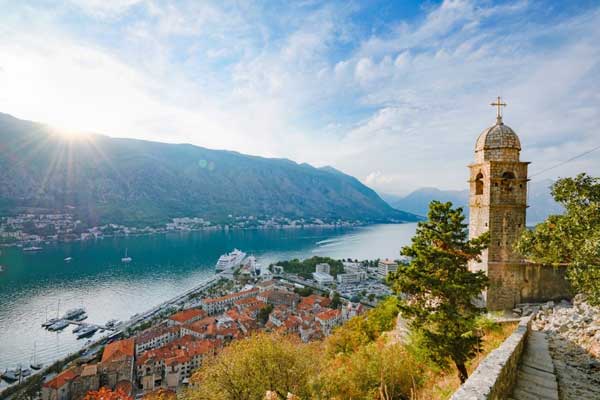
About a dozen winding, mountainous miles north of Budva is Kotor, a 2,200-year-old town that served as a port in the Venetian, Ottoman, and Austro-Hungarian empires, and a German submarine base in World War II. With less than 15,000 residents, it’s even smaller than Budva. However, it’s just as much traveler eye-candy as Budva, only from a different perspective.
Where Budva is a beautiful, seaside town, Kotor is set at the very southern end of Kotor Bay, a narrow, fjord-like inlet surrounded by the Dinaric Alps. It feels more like a piece of ancient Venice transported to Norway. Because of the natural beauty, Kotor is hugely popular with cruise ships in the summer, which can mean a very crowded Old Town.
Kotor’s Old Town is considered the best-preserved Medieval settlement that still exists in the Mediterranean. Like Budva, it’s a jumble of gray-stone, red-tile-roof buildings amid a tangle of stone lanes and alleys running off hither and yon. Only, Kotor’s Old Town is slightly bigger.
Strolling Old Town Kotor, you’ll randomly come upon decent-sized squares that are lined with restaurants and pubs, most of them al fresco at all times of the year. Winter can be quite gray, cold, and rainy—the upside being that you often have Old Town nearly to yourself.
Yuliya and I arrived in Kotor by way of minibus. It’s a roughly 30- to 40-minute ride from Budva and the cost is a quite reasonable €4 ($4.80) per person. The Kotor bus station is about a 10-minute walk from Old Town. You can also hire a taxi for the trip for about €20 to €25 ($25 to $30).
If you want a beautiful, panoramic photo of Old Town Kotor, the mountains, and the expanse of Kotor Bay, then ask a shopkeeper how to navigate to the walkway that will take you up to the Our Lady of Remedy, a tiny little 16th-century, Roman Catholic chapel halfway up a mountain. The walkway is a bit hidden in the back of Old Town, and the 20- to 30-minute hike to the chapel is definitely a workout, especially in wet weather when the stone pathway can be slippery. But the views all along the way are fabulous.
If you keep walking—ever upward—for another 30 minutes or so, you will reach the top and to the medieval St. Ivan’s Fortress, also called San Giovanni Castle, St. John’s Fortress, and Kotor Fortress. Whatever the name, the stone structure—now largely ruins—sits 920 feet above sea level. In all, it’s about 1,350 steps, with scores of switchbacks. If your aim is the fortress, allocate at least two hours of your day, there and back, for the walking, the resting, and the exploring. And bring water—you will get thirsty.
Perast: Pleasure Boats and Palazzi
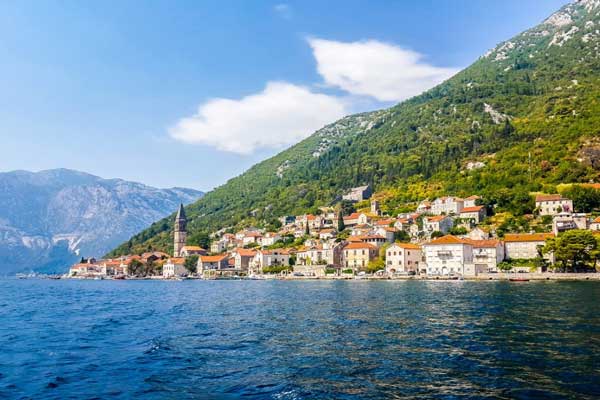
Travel blogs I read about Perast regularly described it as an idyllic fishing village. I don’t know—that’s sort of like describing Miami as a super-cute beach town.
Fishing certainly happens in the vicinity; you’ll see a number of oyster and mussel farms just a few meters offshore as you travel the bayside highway into Perast. But frankly, I didn’t see anything that hinted at Perast being a “fishing village.” The absolutely Lilliputian marina was filled with a few, small pleasure boats and a sailboat, and the houses—stone villas typically several hundred thousand to well over a million dollars in value—are decidedly not fishermen’s quarters.
This bougainvillea-drenched hamlet of less than 350 residents has more than a dozen churches from the 16th through 18th centuries and nearly a score of what were once grand Venetian palazzi. Some of those palazzi have been remodeled into hotels and the summer residences of wealthy Montenegrins and the super-rich foreigners who show up in their yachts and sailboats. Others are in various states of disrepair or remodel. But taken as a whole, this is perhaps the quaintest, seaside village I’ve ever seen. The village has excellent restaurants serving the freshest seafoods, as well as various Montenegrin specialties such as ćevapi (a local sausage) and burek (a pastry filled with meats or cheese or veggies). By the way if you like good wine, Montenegrin wines are excellent and quite cheap.
If you have time—and if the climb to St. Ivan Fortress didn’t wreck your legs—you can climb the 150 steps to the top of the St. Nicholas Church bell tower for a great, treetop view of Perast and the surrounding area, including two tiny islands that seem to float on the placid Bay of Kotor just offshore.
That island pair is St. George Island and Our Lady of the Rocks. You could walk the length of each in about a minute. On both islands sit seriously old churches. The one on Our Lady of the Rocks dates from 1630; the one on St. George from the mid-12th century. You can reach the islands by way of a €5 ($6) boat ride, and you’ll find any number of small boat owners along the bayside promenade eager to ferry you there.
Getting to Perast is simple and fairly quick. Taxis are €12 to €15 ($14.40 to $18) and take about 15 minutes, along a picturesque, waterfront roadway. Or you can hop a bus from Kotor to Risan for €2 ($2.40) or less and just ask the driver to pull over at the Perast bus stop. It’s pretty much the same amount of time.
If you want to stay in Perast a night or two, you will find a range of hotels—from modest to luxury—within those various palazzi dotted throughout town. As the town is quite small, and everything is convenient to everything else, there’s no ideal location, so choose wherever takes your fancy.
Need to Know
Getting to Montenegro: There are no direct flights to Montenegro from the U.S. You’ll need to transit via a major European gateway such as Vienna, Paris, Zurich, Frankfurt, or Istanbul. COVID-19, obviously, has befouled flight schedules, and they’ve been changing all the time as border and travel rules change, so check the Podgorica airport website (MontenegroAirports.com) for an up-to-date list of arrival cities and airlines. Budapest, Brussels, and London are also departure points, but the frequency is much less, often as little as once a week.
When to Go: When to go depends on what you like as a traveler. Summer along the Adriatic is fabulous—warm and sunny most of the time. You will face larger crowds, and higher prices, but all restaurants and attractions are open. Spring and fall are very nice as well—fewer crowds, but sometimes cooler, wetter weather. Winter is doable—it’s certainly not miserable, and the sunny days are splendid and warm. You will have far fewer tourists, but also fewer restaurants and attractions that are open.

Get Your Free Report on the World’s Best Places to Retire:
Learn more about the best places in the world to retire in our daily postcard e-letter.
Simply enter your email address below to sign up for our free daily postcards and we’ll also send you a FREE report on The World’s Top 10 Retirement Havens, plus access to over 10 more free reports. Our gift to you, on our favorite destinations.
Related Articles
Europe’s Top 5 Affordable Retirement Havens
The Best Towns and Cities to Retire in Europe
Planning Your Roving European Retirement
Upcoming Conferences
The Only 2024 Fast Track Panama Conference
If your dream retirement involves stunning beaches… lush green mountains… a warm climate with no hurricanes… first-rate healthcare… incredible value for money (a couple can live well on $2,200 a month)… and the World’s #1 Retiree Discount Program…
Join our Panama experts and expats in February and discover why Panama could be your perfect paradise.
REGISTER NOW, SEATS LIMITED: EARLY BIRD DISCOUNT HERE

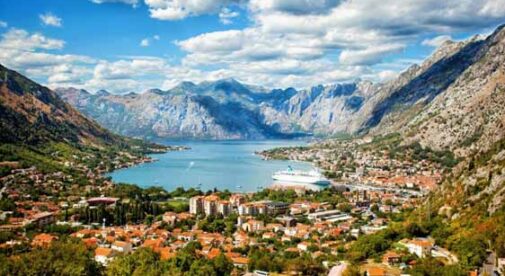
.png)